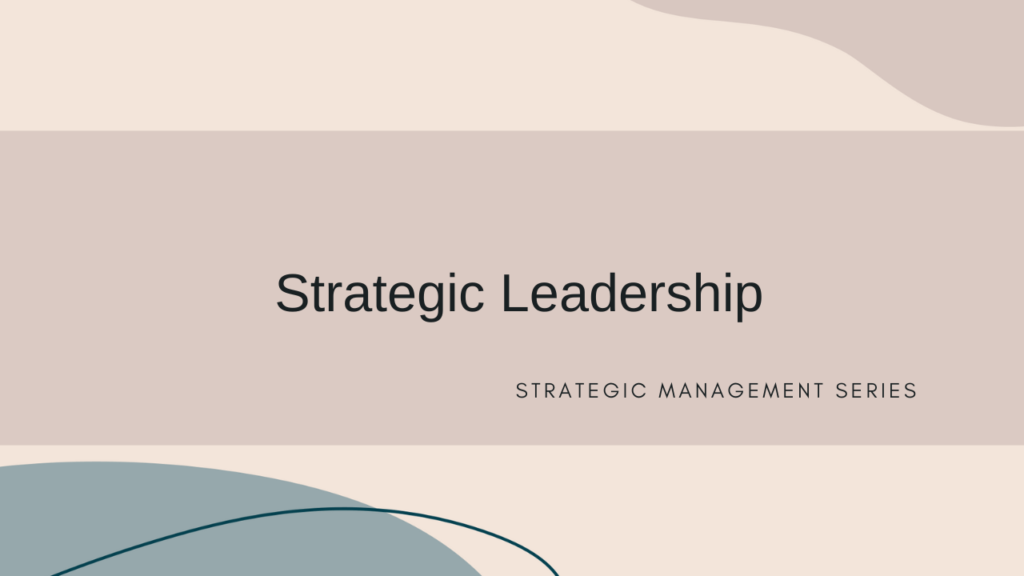Strategic Leadership
Strategic Leadership requires the ability to
- maintain flexibility
- empower others to create strategic change through selecting and implementing a firms strategies as necessary
Strategic Leadership is
- multi-functional work involving working through others
- consideration of the entire enterprise rather than just a sub-unit
- a managerial frame of reference
Effective Strategic Leaders
- manage the firms operations effectively
- sustain a high performance over time
- understand how their decisions affect the internal systems in use by the firm
- ask feedback from peers, superiors and employees about their decisions and vision
The Role of Top-Level Managers
- Managers often use their choice when making strategic decisions and implementing strategies
- Factors affecting the amount of decision making discretion
- External environmental sources
- Characteristics of the organization
- Characteristics of the manager
Factors Affecting Managerial Discretion
a) External Environment
- Industry Structure
- Rate of Market growth
- Number and type of competitors
- Degree to which products can be differentiated
b) Characteristics of the Organization
- Size
- Age
- Culture
- Availability of resources
- Patterns of interaction among employees
c) Characteristics of Manager
- Tolerance for ambiguity
- Commitment to the firm and its desired strategic outcomes
- Interpersonal skills
- Aspiration level
- Degree of self confidence
d) Managerial Discretion
- The degree of freedom for action when making strategic decisions especially those concerned with effective implementation of strategies
- How managers exercise discretion when determining appropriate strategic actions is critical to the firms success
Top Management Teams
- Composed of the key managers who are responsible for selecting and implementing the firms strategies
- A heterogeneous top management team:
- has varied expertise and knowledge
- can draw on multiple perspectives
- will evaluate alternative strategies
- builds consensus
- have difficulty functioning effectively as a team
- requires effective management of the team to facilitate the process of decision making
- are associated positively with innovation and strategic change
- may force the team or members to think outside of the box and be more creative
CEO and Top Management Team Power
- Higher performance is achieved when board of directors are more directly involved in shaping strategic direction
- A powerful CEO may:
- appoint sympathetic outside board members
- have inside board members who report to the CEO
- have significant control over the boards actions
- may also hold the position of chairman of the board (CEO duality)
- Duality often relates to poor performances and slow response to change
- CEOs of long tenure can also have substantial power
- CEOs can gain so much power that they are virtually independent of oversight by the board of directors
Managerial Succession
- Organizations select managers and strategic leaders from two types of managerial labour markets
- Internal Managerial labour market
- Advancement opportunities related to managerial positions within a firm
- External Managerial Labour market
- Career opportunities for managers in organisations other than the one for which they currently work
Managerial Labour Markets
- Advantages of internal managerial labour markets include:
- Advancement opportunities related to managerial positions within a firmExperience with the firm and industry environment
- familiarity with company products, markets, technologies, and operating procedures
- lower turnover among existing personnel
- Advantages of the external managerial labour market include
- As compared with long-tenured insiders, outsiders may bring fresh perspectives
Key Strategic Leadership Actions: Determining Strategic Direction
- Determining strategic direction involves developing a long-term vision of the firms strategic intent
- Five to ten years into the future
- Philosophy with goals
- The image and character the firm seeks
Establishing Balanced Organizational Controls
- Controls
- Formal information based procedures used by managers to maintain or alter patterns in organizational activities
- Controls help strategic leaders to:
- build credibility
- demonstrate the value of strategies to the firms stakeholders
- promote and support strategic change
- The Balanced Scorecard
- A framework used to verify that the firm has established both strategic and financial controls to assess its performance
- Four perspectives of the balanced scorecard
- Financial
- Internal business processess
- Learning and growth
- Customer
Perspectives
Criteria
Financial
- Cashflow
- ROE
- ROA
Customer
- Assessment of ability to anticipate customers needs
- Effectiveness of customer service practices
- Percentage of repeated business
- Quality of communications with customers
Internal Business Process
- Asset utilization improvements
- Improvements in employee morale
- Changes in turnover rates
Learning and Growth
- Improvements in innovation ability
- Number of new producta compared to competitors
- Increases in employees skills
